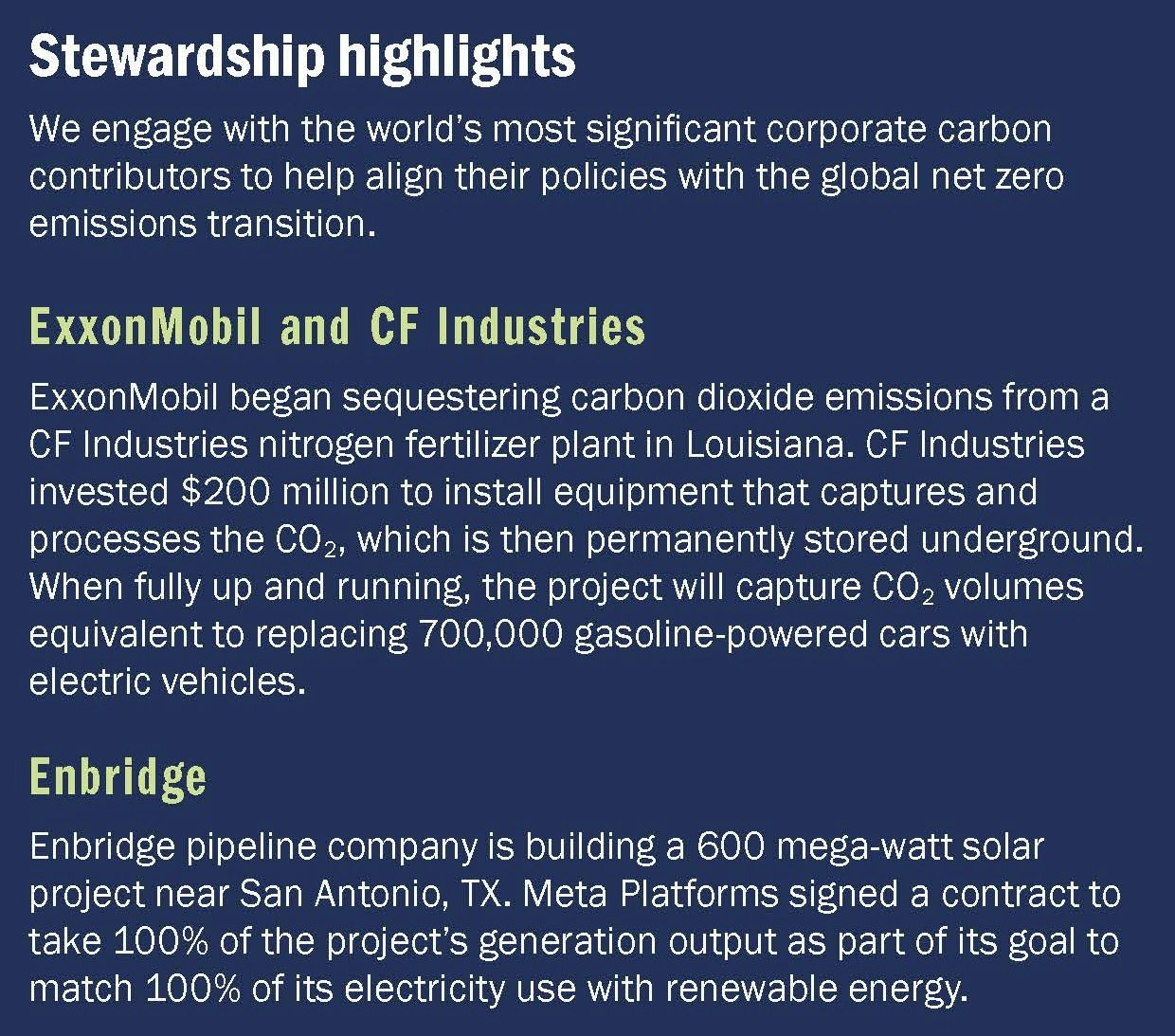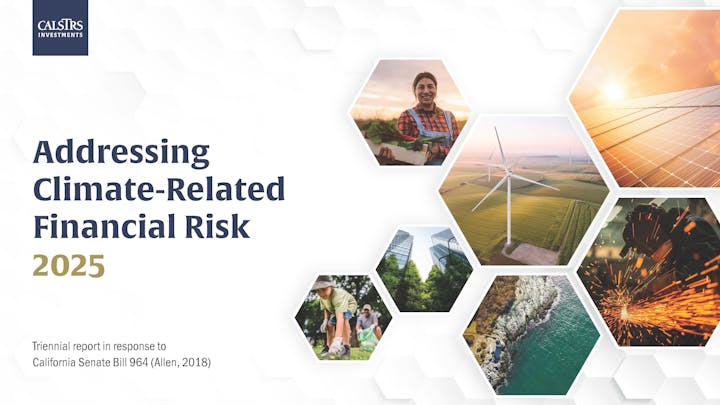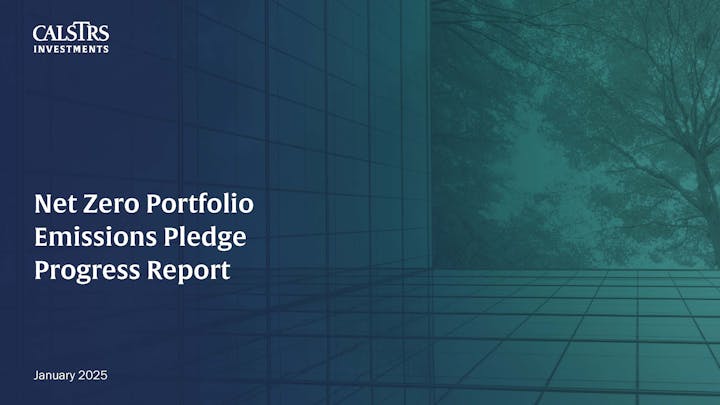Path to net zero
At CalSTRS, we have a fiduciary duty to protect the best interests of our members and beneficiaries by ensuring our portfolio’s long-term financial success. CalSTRS believes that climate change presents material risks to the portfolio and we need consistent, accurate and comparable data from all companies in our portfolio to mitigate climate-related risk and accurately measure and reduce emissions. We will continue to use our voice alongside fellow institutional investors to hold companies accountable for climate-related disclosures. This helps protect the Teachers’ Retirement Fund on behalf of our members and their beneficiaries.
In September 2021, the Teachers’ Retirement Board pledged to achieve net zero greenhouse gas emissions across the CalSTRS Investment Portfolio by 2050, or sooner. The Board later adopted a science-based interim goal of reducing emissions from the portfolio by 50% by 2030.
Net zero means the amount of greenhouse gases emitted is offset by the amount taken away. The Board's pledges acknowledge the importance of the climate change challenges impacting the world and helps ensure we remain resilient and sustainable.
These actions integrate our net zero strategy across the CalSTRS Investment Portfolio in a total fund approach. This strategy has three pillars:
- Managing and reducing emissions in the portfolio.
- Influencing policy makers, companies and financial markets to speed up the global low-carbon transition.
- Increasing investments in climate solutions.
Managing and reducing greenhouse gas emissions
The first pillar of our net zero strategy is managing and reducing portfolio emissions, which are the greenhouse gases emitted by the companies and assets we invest in on behalf of California’s public educators. We do this by using science-based tools to measure emissions in our portfolio. Our goal is to align our emissions reductions with the Paris Climate Agreement. We report these measurements regularly and use them to inform our investment decisions and our priorities for influencing companies and policy makers.
We will continue to focus on stewardship and engagement efforts and investing in climate solutions that will further reduce greenhouse gas emissions and risks related to our portfolio.
Recent activities
The Global Equity team implemented an emissions reduction strategy by allocating 20% of the Total Public Equity portfolio to a low-carbon index, approved at the September 2022 Investment Committee meeting. As of June 30, 2025, approximately $30.8 billion or 20.7% of the portfolio is being managed internally against the low-carbon index. Staff estimates this has yielded portfolio emissions reductions of approximately 16.4%.
The Fixed Income team implemented an emissions reduction program through an initial 15% carbon reduction strategy, approved by the Teachers' Retirement Board at the May 2023 Investment Committee meeting. In this strategy, Fixed Income’s credit-related indices reduce carbon emissions incrementally each month while seeking to maintain parent index metrics and minimizing additional active risk. At the same time, Fixed Income’s credit-related portfolios reduce emissions in like fashion.
Speeding up the transition
One of the three components of CalSTRS pledge to reach net zero portfolio emissions by 2050, or sooner, is to use our influence to accelerate the transition to manage risks in our portfolio. Climate change presents a material and significant risk to society, the economy and our portfolio. CalSTRS is committed to engaging the highest carbon emitting companies to reduce emissions in the global economy. This is aligned with CalSTRS pledge to achieve net zero portfolio emissions by 2050, or sooner.
Recent activities
As part of the 2025 proxy season, CalSTRS increased the scrutiny of our votes against boards that are not appropriately managing and addressing sustainable business practices. We voted against the boards of directors at 1,661 global companies because they did not provide necessary climate risk disclosures. Disclosure is important for investors to appropriately assess the financial risk climate change poses to a company's long-term profitability. We believe that our Stewardship Priorities are areas where we can meaningfully influence and deliver measurable outcomes that support long-term performance of the CalSTRS Investment Portfolio and protect our members’ retirement benefits.
Recent stewardship engagements
Examples of our engagements include:


Investing in climate solutions
We focus on investing in companies and assets that meet our investment return objectives and reduce portfolio emissions, such as producing renewable energy or constructing and managing buildings that meet the highest standards for energy efficiency.
Since 2004, we have been actively integrating climate-oriented solutions into our portfolio and have invested more than $52.9 billion in low-carbon solutions.
Recent activities
The SISS Private Portfolio, which was approved by the Investment Committee in 2021 to create a systematic platform to expand investments in low-carbon solutions, has deployed over $4.4 billion as of June 30, 2025 across a broad risk-return spectrum.
The private asset classes have been working to increase exposure to low-carbon solutions. Examples of these types of efforts include:
- CalSTRS' emissions reduction plan includes establishing a comprehensive solar energy strategy for the portfolio. In early 2024, staff engaged a global sustainability consultant to develop an action plan to implement solar opportunities across the Real Estate portfolio. Working with staff to understand investment objectives and risk tolerances, the consultant provided perspective on various solar business models and opportunities that Real Estate could explore in collaboration with solar partners. In late 2024, CalSTRS began the second phase of the solar strategy, focusing on a subset of the Real Estate portfolio. This second phase includes data collection, feasibility analyses, categorization of assets into suitable ownership structures, and the optimal installation approach to generate maximum value for the portfolio. Staff will continue to provide annual progress updates to the Investment Committee.
- CalSTRS continues to be an owner and investor (alongside APG in the Netherlands and ADIA in Abu Dhabi) in Arevon Energy, a renewable Independent Power Producer that develops, builds, owns and operates solar and storage projects in a diversified power markets across the U.S. Arevon ranks as one of the largest solar operating companies in the United States, and its solar and storage businesses positively contribute to the energy transition and climate change mitigation efforts. Arevon is a preeminent developer and holder of renewable energy assets that oversees a total operating portfolio of over 5.0 gigawatts (1 gigawatt is equivalent to 1 billion watts and is estimated to power 750,000 homes per year).
- A $30 million investment into a leading robotics and AI company that improves waste sortation and recycling. The company increases landfill diversion rates to 60-80%, increases recycling purity rates to 99%+, and eliminates waste sorting hazards for workers. Waste disposal is one of the largest contributors to greenhouse gas emissions and the company's core business enables traditional waste companies to reduce their emissions while improving recycling initiatives in a way that lowers overall costs.
- CalSTRS has an ownership stake in Generate Capital, a leading sustainable investment and operating company that builds, operates and finances clean energy, transportation, water, waste and digital infrastructure. Founded in 2014, Generate Capital was an early mover to scale in distributed solar, energy storage and microgrids, owning and operating 430 megawatts of distributed solar, 540 megawatts of battery storage, and 498 megawatts of microgrids. The company has also built a waste-to-value infrastructure company with the capacity to process more than 1.6 million short tons of organic waste, providing solutions to municipal, industrial and agricultural customers in Canada, the United States and the U.K.



